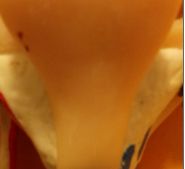Ultrasound-guided injections of hyperosmolar dextrose for overuse patellar tendinopathy (2011)
Ryan M; Wong A; Rabago D; Lee K; Taunton J. Ultrasound-guided injections of hyperosmolar dextrose for overuse patellar tendinopathy: a pilot study. Br J Sports Med. 2011 Sep;45(12):972-7. doi: 10.1136/bjsm.2010.081455. Epub 2011 Feb 21.
Dr. Reeves' Notes: Chronic infrapatellar tendinopathy presents a challenge to the physician, especially after failing conservative exercise-based treatments. No single therapy has been identified. Dextrose injection treatments show promise for helping reduce pain at the plantar fascia, Achilles and adductor tendon injury sites. Ryan et al conducted a consecutive patient study of 47 subjects with a mean of four injection sessions and showed a reduction in pain and a correlated improvement in the ultrasound appearance. This suggests that dextrose affects patellar tendinopathy at a tissue level.
ABSTRACT
Purpose: To evaluate whether ultrasound-guided injection of hyperosmolar dextrose for treatment of patellar tendinopathy decreases pain scores and normalises the appearance of the patellar tendon on ultrasound.
Methods: Subjects were referred from primary care clinics and failed conservative treatment. Subjects received a diagnostic ultrasound examination, then ultrasound-guided injection of 25% dextrose with lidocaine into the area of tendinopathy until they were satisfied with treatment. The primary outcome measure was a three-part visual analogue scale (VAS; baseline and mean of 45 weeks after start of treatment) for pain at rest, activities of daily living (ADL) and during sport. Secondary outcomes included segmental ultrasound examinations assessing tendon hypoechogenicity (area and severity score), neovascularity (severity score) and the presence or absence of intratendinous tearing and calcification, irregularities of cortical bone and thickness.
Results: 47 consecutive referrals were included. Subjects received a mean of four (3) injection sessions. At mean 45 weeks post-enrollment, subjects reported a reduction in pain across the three VAS items (rest 38.425-18.718.4; ADL 51.122.9-25.820.1; sport 78.115.7-38.826.1; p <0.01). There was improvement in neovascularity following the dextrose injection. A significant correlation between hypoechogenicity severity scores and pain at follow-up is reported.
Conclusion: There was a reduction in pain and an improvement in ultrasound appearance following ultrasound-guided dextrose injections for refractory patellar tendinopathy. An improved hypoechoic appearance of the tendon was associated with decreased pain scores, suggesting that dextrose injections may modify patellar tendinopathy at the tissue level and that fibrillar changes may play a role in tendon nociception.
Ryan M; Wong A; Rabago D; Lee K; Taunton J. Ultrasound-guided injections of hyperosmolar dextrose for overuse patellar tendinopathy: a pilot study. Br J Sports Med. 2011 Sep;45(12):972-7. doi: 10.1136/bjsm.2010.081455. Epub 2011 Feb 21.
Dr. Reeves' Notes: Chronic infrapatellar tendinopathy presents a challenge to the physician, especially after failing conservative exercise-based treatments. No single therapy has been identified. Dextrose injection treatments show promise for helping reduce pain at the plantar fascia, Achilles and adductor tendon injury sites. Ryan et al conducted a consecutive patient study of 47 subjects with a mean of four injection sessions and showed a reduction in pain and a correlated improvement in the ultrasound appearance. This suggests that dextrose affects patellar tendinopathy at a tissue level.
ABSTRACT
Purpose: To evaluate whether ultrasound-guided injection of hyperosmolar dextrose for treatment of patellar tendinopathy decreases pain scores and normalises the appearance of the patellar tendon on ultrasound.
Methods: Subjects were referred from primary care clinics and failed conservative treatment. Subjects received a diagnostic ultrasound examination, then ultrasound-guided injection of 25% dextrose with lidocaine into the area of tendinopathy until they were satisfied with treatment. The primary outcome measure was a three-part visual analogue scale (VAS; baseline and mean of 45 weeks after start of treatment) for pain at rest, activities of daily living (ADL) and during sport. Secondary outcomes included segmental ultrasound examinations assessing tendon hypoechogenicity (area and severity score), neovascularity (severity score) and the presence or absence of intratendinous tearing and calcification, irregularities of cortical bone and thickness.
Results: 47 consecutive referrals were included. Subjects received a mean of four (3) injection sessions. At mean 45 weeks post-enrollment, subjects reported a reduction in pain across the three VAS items (rest 38.425-18.718.4; ADL 51.122.9-25.820.1; sport 78.115.7-38.826.1; p <0.01). There was improvement in neovascularity following the dextrose injection. A significant correlation between hypoechogenicity severity scores and pain at follow-up is reported.
Conclusion: There was a reduction in pain and an improvement in ultrasound appearance following ultrasound-guided dextrose injections for refractory patellar tendinopathy. An improved hypoechoic appearance of the tendon was associated with decreased pain scores, suggesting that dextrose injections may modify patellar tendinopathy at the tissue level and that fibrillar changes may play a role in tendon nociception.
